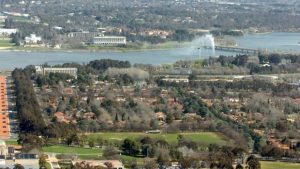
Changes that would encourage more people to subdivide blocks in the ACT’s older suburbs could be on the way, in spite of most Canberrans clinging to the dream of a quarter-acre block.
Separate unit titling of dual occupancies in RZ1 zones has been floated as a way of meeting the demand for medium-density housing in Canberra’s more established suburbs.
A new discussion paper on the ACT’s future housing choices said more than half of Canberrans surveyed wanted more dual occupancies in their area.
Dual occupancies are allowed on RZ1 land but only on blocks larger than 800 square metres.
The unit titles for the properties also can’t be separated, meaning they must be sold together.
Nearly half of people surveyed said they would subdivide their block and build another house if it could be separately unit titled and sold individually.
That dropped to less than 7 per cent if the unit title could not be separated.
RZ1 rules cover 81 per cent of Canberra’s residential land, which is largely single residences.
Securing a bank loan to build a dual occupancy under the current rules is hard and there are few dual occupancies in RZ1 zones because of this.
The average block size in Canberra is also falling.
Between 1987 and 2007, the average block size fell by 3 per cent to 835 square metres.
Most new blocks in Canberra are less than 600 square metres.
But the discussion paper said despite this trend, there are still very large blocks in some of Canberra’s existing suburbs that may be appropriate to subdivide.
“To encourage a range of new developments within existing neighbourhoods, subdivision of large accessible blocks (e.g. corner blocks or blocks with large frontage) or consolidation and subdivision of blocks are options that could be considered,” it reads.
The paper pointed to Canberra’s changing demographics as one of the reasons why a mix in the ACT’s housing supply needed to be explored.
Canberra is one of the fastest ageing capital cities in Australia, it said, and nearly 80 per cent of those surveyed over 65 said they wanted to stay in the same area as they got older.
Household sizes have also shrunk.
In 1911, the average Australian household contained 4.5 people.
In 2016, the average ACT household was 2.5 people.
Despite this, the average floor area for new single dwelling houses in the ACT increased by 53 per cent between 1984-85 and 2002-03.
However Canberrans expressed a preference for even more space.
About 30 per cent of survey respondents said they current lived on a separate block between 800 and 1049 square metres.
However more than 50 per cent said they expected to move to a block that size in future and over 40 per cent said they would live on a block that size in an ideal world.
Nearly 30 per cent said they would like to live on a block largest than 1050 square metres.
Only a fraction said they would like to live in a unit block greater than three storeys.
However the paper noted the ACT had a “finite” supply of new land.
While construction began on more housing in 2013-15 than it did in 1999-2001, it was dwarfed by other kinds of housing developments.
The discussion paper also raised the possibility of increasing the density allowed in RZ2 zones, which currently allows dual occupancies, town houses and terraces but no apartments.
It said there could be a “sliding scale of development density” depending on the number of adaptable units in a proposal.
The dwelling replacement rules, which says at least one unit in a development must contain the number of bedrooms as the detached house it replaced, could be scrapped.
“This would allow the market to drive the number of bedrooms in new developments,” the paper reads.
Community feedback on the consultation paper will be used in the review of the ACT’s planning strategy, which will be released in 2019.
You can have your say on it until March 9, 2018: yoursay.act.gov.au/housing-choices
From The Canberra Times – Katie Burgess Canberra Times 18 November 2017


